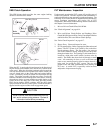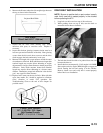
6.8
CLUTCH SYSTEM
Drive Clutch Spring
The drive clutch spring has two primary functions:
1. Controls clutch engagement RPM. The springs which
have a higher rate when the clutch is in neutral will
increase clutch engagement RPM.
2. Controls the rate at which the drive belt moves upward
in the drive clutch sheaves. This is referred to as drive
clutch upshift.
The drive clutch spring is one of the most critical components
of the PVT system. It is also one of the easiest to service. Due
to the severe stress the coil spring is subject to during operation,
it should always be inspected for tolerance limits during any
clutch diagnosis or repair.
There are other components which control upshift, but the
spring is one of the primary components in insuring optimum
performance. It is very important that the spring is of correct
design and is in good condition.
Measuring Spring Length: With the spring resting on a flat
surface, measure its free length from the outer coil surfaces as
shown. Refer to the spring specification chart for specific free
length measurements and tolerances. Also check to see that
spring coils are parallel to one another. Distortion of the spring
indicates stress fatigue, requiring replacement.
CAUTION
Never shim a drive clutch spring to increase its
compression rate. This may result in complete stacking
of the coils and subsequent clutch component failure.
Table 6-1: Primary Clutch Springs
PART #
C
OLOR
C
ODE
WIRE DIA.
F
REE L ENGTH
”
7041021 Plain .157” 4.38”
7041022 Black .140” 4.25”
7041063 Purple .168” 4.37”
7041132 White .177” 2.92”
7041168 Green .177” 3.05”
7041157 Blue/Green .177” 2.53”
Table 6-2: Secondary Clutch Springs
PART #DESCRIPTION
3234199 White


















